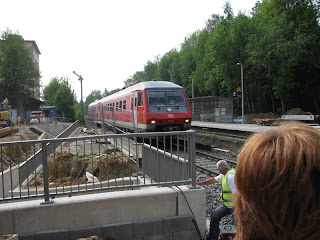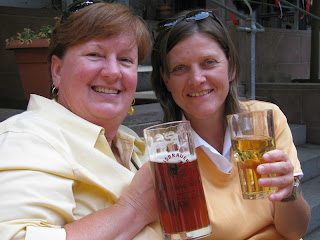We caught a 9:30 AM flight on Alitalia from Rome to Munich, arriving at 10:45 AM where we were met by our friend, Karin. We met her a number of years ago at Saddlebag Lake near Yosemite, where we all helped Debbie’s Aunt & Uncle at their little fishing resort. Karin is related to Debbie’s Aunt by marriage, and helped at the resort for several summers. Anyway, we visited her in Germany in 2005, and have wanted to come back ever since. In 2009, Karin married Wolfgang, a landscaper by trade, and an extremely talented man.
Karin drove us to her mother’s house in Bernstadt, about 1.5 hours from Munich, near the city of Ulm. She had a delicious lunch ready for us as soon as we got there. In Germany, it is traditional to have the largest meal of the day at noon, which is really quite a good idea. After lunch, we had a nice visit with Mom, and then traveled across the small village where she lives to Karin’s brother, Wolfgang’s, home. We met Wolfgang his wife, Margret, and their three children, Tabea, Leoni and Philip, six years ago, so it was great to get to visit with them, again. Their daughters are now 15 and 16, and are quite grown up. Their son, Philip, is now twelve, and is struggling with his English. In Germany, everyone takes English as one of their regular classes, so young people all understand the language, and most can speak it quite fluently. Margret fixed us a great dinner and we spent the night at their home.
The next morning after breakfast, Karin took us on a walk along a meadow trail next to the woods. The walk was about 4 kilometers or almost 2 miles. Once we returned to town, we were ready for another lunch at Mom’s. We were joined for this meal by Wolfgang and Margret, as well as by Karin’s other brother, Ralf.
After lunch, we got in the car and traveled to Karin & Wolfgang’s (the husband, not the brother) home in Poppenricht, a small village near Amberg, about 2 hours north of Munich. The closest large city is Nürnberg, or as it is known in America, Nuremburg. Poppenricht is a village of 300-400 homes located at the edge of a large patch of woods. Karin & Wolfgang’s home backs up to the woods, so no one can build behind them. Because Wolfgang is a landscaper, his yard is a mass of color. He has extensive rock gardens both in front of and behind the home. In addition, he has a greenhouse that presently houses a rabbit hutch, as well as a chicken house that contains several chickens and turkeys. Behind the back fence, in the edge of the woods, Wolfgang has several beehives. He also has a large woodworking shop as well as storage for his landscaping equipment and supplies. The roofs of the shop, storage barn and carport are all planted with herbs and flowers.
Debbie met Wolfgang in 2009 when he and Karin were in the US for their American wedding reception and honeymoon, but Tom was delayed with a motorhome problem and missed their reception, and with it, the chance to meet Wolfgang until now. Wolfgang has two children, Hanna, who is 22 and is currently in Paraguay working with the local people, and Jonathon, a 17 year-old who lives with Karin and Wolfgang and attends ‘gymnasium’, an advanced high school.
On Friday, we traveled with Wolfgang and Karin to Flossenbürg and a nearby Nazi concentration camp. The camp first opened in 1935 because it was adjacent to a granite quarry and workers were needed to cut the granite for use in building Nazi monuments. The first prisoners were political opponents of the National Socialist Party (Nazi), but once Germany was at war with other European nations, prisoners from those nations were brought into the camp. My understanding has always been that the concentration camps were primarily for Jewish prisoners, but at least this camp held prisoners of war from as many as 25 countries as well as Jews. At one time the population of the camp was about 100,000, but when the camp was liberated by the 90th US Infantry Division on April 23, 1945, there were only about 1,500 critically-ill prisoners remaining in the camp. All of the others had been driven out of the camp in the so-called death marches in early April.
Portions of the camp have been maintained as a Memorial to those who died as prisoners. A chapel was built with the stones of demolished watch towers; a remaining watch tower serves as the church spire.
The ‘Valley of Death’ starts at the camp gate and leads down to the crematorium, execution area and pyramid of human ashes.
Most of the buildings were wooden, and except for the rock foundations laid by the prisoners, nothing remains. Several concrete buildings remain, including the camp laundry and prisoners’ shower area.
In the late 1950’s a Cemetery of Honor was constructed in the area where the isolation blocks and the disinfection building were previously located. More than 5,500 people were reburied in individual graves in the cemetery.
From Flossenbürg we traveled a few miles to a very large nursery where Wolfgang selected a number of plants that he needed for his current jobs. We had time to wander around the nursery and look at the beautiful garden displays before returning home.
On Saturday, Wolfgang harvested honey from his hives, and with help from Tom and Jonathan, spun the honey out of the honeycomb into three large tubs. This harvest totaled over 80 kilograms, or about 190 pounds.
After the honey drips through fine cloth filters, it will be put into jars for personal use and for sale.
On Saturday evening, they had a party to celebrate Wolfgang’s birthday which had occurred several days earlier. It was combined with a birthday party for a friend and neighbor, Martin, and about 25 friends were invited to the celebration. We felt very honored to be included, and after a wonderful dinner of Osso Buco prepared by Karin and Debbie, the laughter and beer continued into the wee hours.
Wolfgang and Karin are very involved with their church, so they were gone all Sunday morning, while we enjoyed a leisurely breakfast and some quiet time. On Sunday afternoon, we were thrilled to have a visit with friends we’d met in our earlier visit to Karin’s; Peter and Marion, and their two sons, Timon (17) and Silas (15).
They had been in Weissenburg on Saturday for a wedding, and stopped to see us on their way home. It was great to have the chance to visit with them again.
Monday was another day at home, but in the afternoon, Karin decided that we should go elderberry blossom picking in the nearby woods.
That was much fun, but also a long walk; at least 4 kilometers, mostly up and down hill. They use the blossoms for making elderberry tea, or sometimes, elderberry syrup. In the fall, they pick the berries themselves, and make a fruit drink that is tasty and supposedly very good for you. Tom’s had a cough since early in the trip, and an elderberry drink before going to bed seemed to suppress the cough through the night.
On Tuesday morning we traveled to the nearby town of Sulzbach-Rosenberger to catch a train to Nürnberg.
The trip took about 45 minutes and ended in the center of the city. A short ride on the Metro, or as it is known in Germany, the U-Bahn, brought us into the old city, dating back to medieval times. The Danube River runs through Nürnberg, so the city has been a commercial center for many centuries. We spent some time in the central square which hosts a daily farmers market. As in Italy, this market is the source for most fresh fruit and vegetables for the local population. We took a walking tour of the old city with commentary in English. Karin and us were joined for the tour by two young Australian girls in Nürnberg for a few days. Our local guide was very knowledgeable and spoke beautiful English.
A church in the central square has a clock and ‘glockenspiel’, built in the 1500’s, that strikes and plays every day at noon. In the square there is also a tall water fountain that was first used to provide water for the entire city.
We walked to an old protestant church, built in the 1100’s in a Romanesque style. It was soon found to be too small, so an addition that doubled the size of the church was constructed, this in a Gothic style. It is interesting to see both styles in one building.
From there we walked up a block or so to see the City Hall, then through a small brewery, the only one still operating in Nürnberg, on our way to the Imperial Castle on the top of a hill.
The castle, first constructed in the 11th century, was built as a traveling home to the Kings of the Holy Roman Empire who moved around the various cities of the Holy Roman Empire. Like the church mentioned earlier, the castle was originally built in the Romanesque style, while later additions and renovations were done in the Late Gothic style.
At the conclusion of the tour, we retraced our steps to the brewery, the Hausbrauerei Altstadthof.
It is a small brewery, serving just in their own pub and brew garden, and it has been in existence since the 1500’s. They make several varieties of beer, and also beer schnapps. We tried a red beer and a black beer, and both were superb. From there, we went back to the city center for lunch and a little shopping before returning home on the train.
Our last day in Bavaria was a lazy one. It rained most of the day, so Tom spent the day working on the blog, and Debbie slept in for most of the morning. She and Karin went shopping in the afternoon, and Wolfgang’s mother and father came over for dinner in the evening. Wolfgang is very happy that it rained, watering his whole garden at once.
Tomorrow is our getaway day. Karin will take us back to the Munich airport in time for an 11:30 AM flight to Washington DC, where we’ll have a couple of hours before boarding our flight to SFO. It will be a very long day, since we’ll pick up the nine hours we’ve lost since leaving home, as well as the actual flight time. Hopefully with the help of a sleeping pill, we’ll be able to sleep at least part of the way home.
















No comments:
Post a Comment